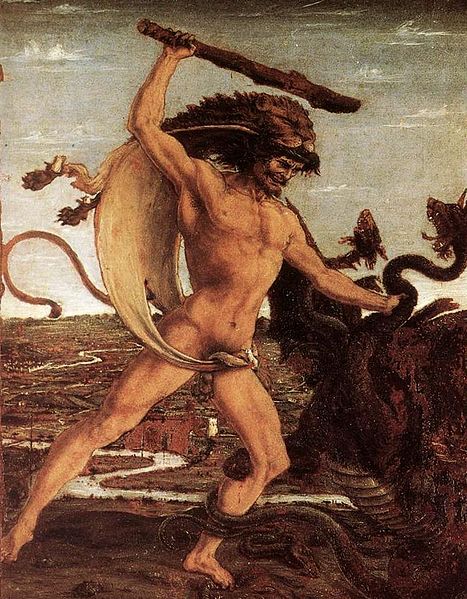![467px-Hercules_and_the_Hydra_-_Antonio_del_Pollaiolo[1]](https://mysteriouswritings.com/wp-content/uploads/2012/06/467px-Hercules_and_the_Hydra_-_Antonio_del_Pollaiolo1-233x300.jpg) Many stories seem to be created by using bits and pieces of long forgotten myths or legends. Fragments from memories are pulled together to form new and strange tales. The mysterious Blue Hole is one of these fascinating tales which casts a semblance to accounts of the lost waters of Lerna; believed to have been an entrance to the Underworld.
Many stories seem to be created by using bits and pieces of long forgotten myths or legends. Fragments from memories are pulled together to form new and strange tales. The mysterious Blue Hole is one of these fascinating tales which casts a semblance to accounts of the lost waters of Lerna; believed to have been an entrance to the Underworld.
The region of Lerna, located south of Argos (Greece), was known for its mysterious waters. In the popular legend of the twelve labors of Hercules, Hercules needed to travel there in order to slay the monstrous beast known as Hydra. Hydra, described as a ruthless serpent-like creature with many heads, lived within a cavernous lair in the waters of Lerna. It guarded the entrance to the Underworld.
The frightful beast terrified neighboring lands at night and was thought to be impossible to kill. Any time one of his heads was cut off, two would grow back. One of his heads was even said to be immortal. Nonetheless, Hercules was eventually able to slay the serpent. He buried the immortal head under a large rock and moved on to his third labor.
People today, who have heard the stories surrounding the Blue Hole, located in Southern New Jersey (USA), may recognize a correlation. The uniquely colored blue pool of water, in the middle of a marshy wooded area, is also said to be an entrance to the Underworld and a place where the notorious Jersey Devil is often seen. The Jersey Devil has been terrorizing lands across New Jersey, off and on, for hundreds of years. Countless sightings of the unexplained serpent-like flying creature with a horrible screeching voice have been reported since the 1700’s.
However, this relationship between pools of water goes beyond just entrances to the Underground and harboring a beast. The characteristics of these mysterious waters coincide perfectly with each other in another ancient legend.
Dionysus, in efforts to rescue his mother, Semele, from the Underworld, dove into the center of Lake Alcyonian where the entry to Hades was located. Lake Alcyonian was part of the swampy waters of Lerna.
Pausanias (2nd century AD), a Greek traveler and geographer, described the perilous Lake Alcyonian in his Description of Greece;
“There is no limit to the depth of Lake Alcyonian, and I know of nobody who by any contrivance has been able to reach the bottom of it since not even Nero, who had ropes made several stades long and fashioned them together, tying lead to them, and omitting nothing that might help his experiment, was able to discover any limit to its depth. This, too, I heard. The water of the lake is, to all appearance, calm and quiet, but, although it is such to look at, every swimmer who ventures to cross it is dragged down, sucked into its depths, and swept away.”
When considering the description of Lerna to that with the following of the Blue Hole, the similarities are striking. The Blue Hole is said to be:
- a bottomless body of water
- Visitors are warned not to go swimming there, because although the water looks calm, unexplained currents or whirlpools are known to suck down swimmers
- Swimmers who have ventured in (and survived) describe an eerie feeling of being pulled from below and quickly jump out.
- the water is unusually cold
- talk of a guardian beast
- entrance to the Underworld
The Blue Hole is about 70 feet wide and circular with steep banks. It earns its name from the astonishing color of the water. Most other waters in the area are murky and brown; the Blue Hole remains crystal clear.
It would seem the extraordinary pool of New Jersey, like many other tales, shares some of its mystery with stories told of old. As the region and legends of Lerna are ancient, there are still other semblances with other tales. Many of these arise over connections to the Danaids myth. A myth which fifty daughters marry, but, upon their wedding night, cut off their husbands heads (all but one). Accounts tell of the heads being tossed into the marshes of Lerna.
Lerna was an area abundant with springs. And although debated, suggestions have been made that since a ‘head’ can represent ‘source’, the burying of heads in the springs may imply Lerna as a wellspring/headspring. This is further supported by the invention of wells being attributed to Danaus. The importance given to the heads in the story, possibly leads to later significances of revering heads.
Other links are found with the punishment for the Danaid’s crime. The punishment was the ever filling of a leaking vessel; a fruitless task. This connects to broken vessels portraying the uninitiated. It is unclear whether the attempt to fill a leaky vessel was first attributed to the uninitiated or the Danaid’s. Either way, the punishment may suggest the Danaid’s unwillingness to hold a marriage ‘sacred’ is connected to the uninitiated to the mysteries.
Researching old myths and then hearing new, brings similarities and awareness to mind. One begins to wonder if there are any new stories, today.
Sources:
Legends of the Blue Hole, Weird NJ, reviewed June 2012
Harvard studies in classical philology, reviewed June 2012


This is the first time I’ve read this one. It’s fascinating. Those people had a lot of imagination.